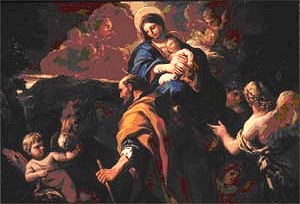 |
|
THE FLIGHT INTO EGYPT
Luca Giordano Italian
1634-1705
SN 157 Oil on Canvas c. 1696
by Robert Anderson
ARTIST
Luca Giordano was the most important decorative artist of the second half of
the 17th century. He succeeded Jusepe Ribera as the preeminent artist of Naples and then
inherited the mantle of Pietro da Cortona as the leading painter of decorative cycles in
Italy. Giordano was nicknamed Luca Fa Presto because of his speed of execution and his
prodigious output. He also had a particular talent for imitating almost any painter's
technique. |
While he was at first influenced by Ribera when
living and working in Naples, he later drew on the ideas of other artists, Murillo, Rubens
and above all the Venetians and Pietro da Cortona. He introduced a new sense of light and
glowing color, of movement and dramatic action. The warmth in the faces of many of his
figures indicates a lasting influence of Rubens.
Giordano was a prolific draughtsman and prepared his works in drawings and
oil sketches. He controlled a large workshop in which his pupils made copies of his
sketches
as well as p;aying a role in some of his fresco cycles.
SUBJECT
This subject is based upon the New Testament
Gospel of Matthew 2: 13-15. Warned in a dream that Herod the King was searching for the
infant Jesus to kill him, Joseph took him and his mother away to safety in Egypt where
they remained until after Herod's death.
The bare statement given by Matthew was greatly amplified in various
New Testament apocryphal texts which are the source of the themes found in art.
The rest on the flight was a popular theme in the art of the Counter
Reformation and was more often of a devotional than a narrative character. In it the
Virgin and Child
ride a donkey while Joseph walks beside them. The angels direct, and guide the group and
assist in leading the donkey.
The Biblical account of the sojourn in Egypt is so brief that such an
episode as the rest is not mentioned. The flight into Egypt was, in fact, the invention of
Christian mythologists who were eager to expand on the few references to Jesus' early
life.
PAINTING
This Ringling Flight into Egypt is considered a particularly strong
painting from this the final period of Giordano's activity. To convey the effect of night,
he adopted Murillo's brown tonality instead of the colorful palette he normally used. The
poses of both Joseph and the Angel are derived from Murillo compositions which Giordano
had had an opportunity to study during his time in Spain (1692-1702).
The vigorous brushwork and gathering clouds with angels lend an
animation to the picture that serves to heighten the sense of urgency of the Holy Family's
flight. The horizontal format and large scale of the painting place the viewer close to
the scene as if the entourage were passing directly in front of him.
HISTORICAL CONTEXT
Although his art was not universally understood or appreciated during
his lifetime, his fame was nevertheless enormous. in Venice his fame spread rapidly.
Venetian artists were attracted by the warmth and color of his paintings, by his Baroque
sense of space and by the contrasts of light and dark inspired by Ribera. Patrons included
Cosimo III de' Medici, Charles II and King Louis XIV of France.
|
